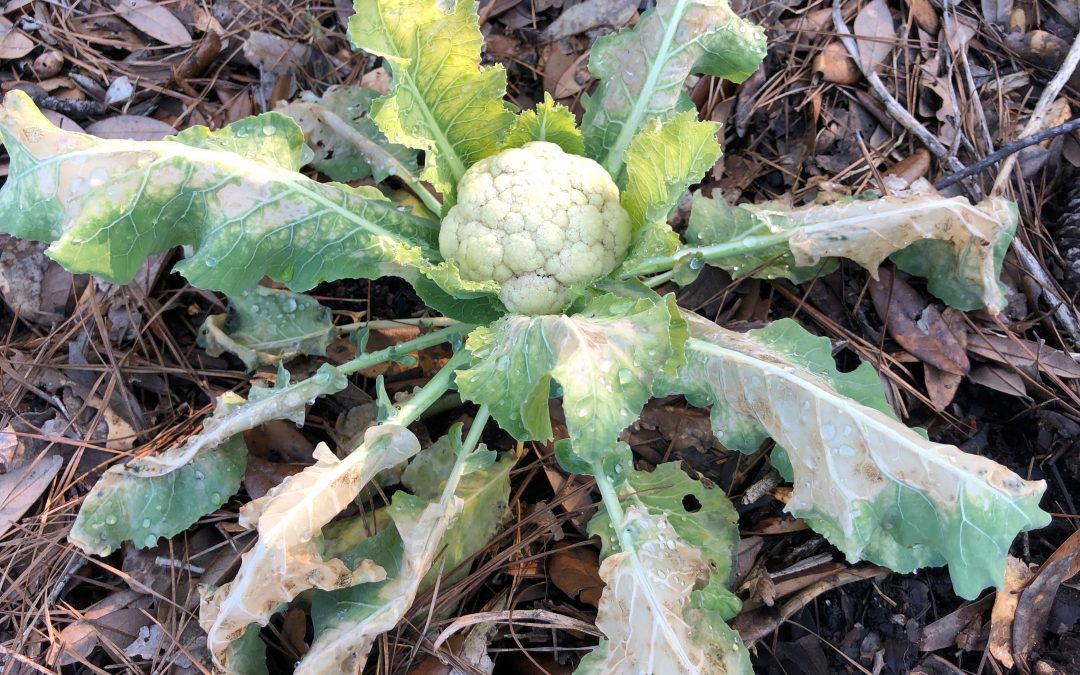
by Molly Jameson | Dec 10, 2021
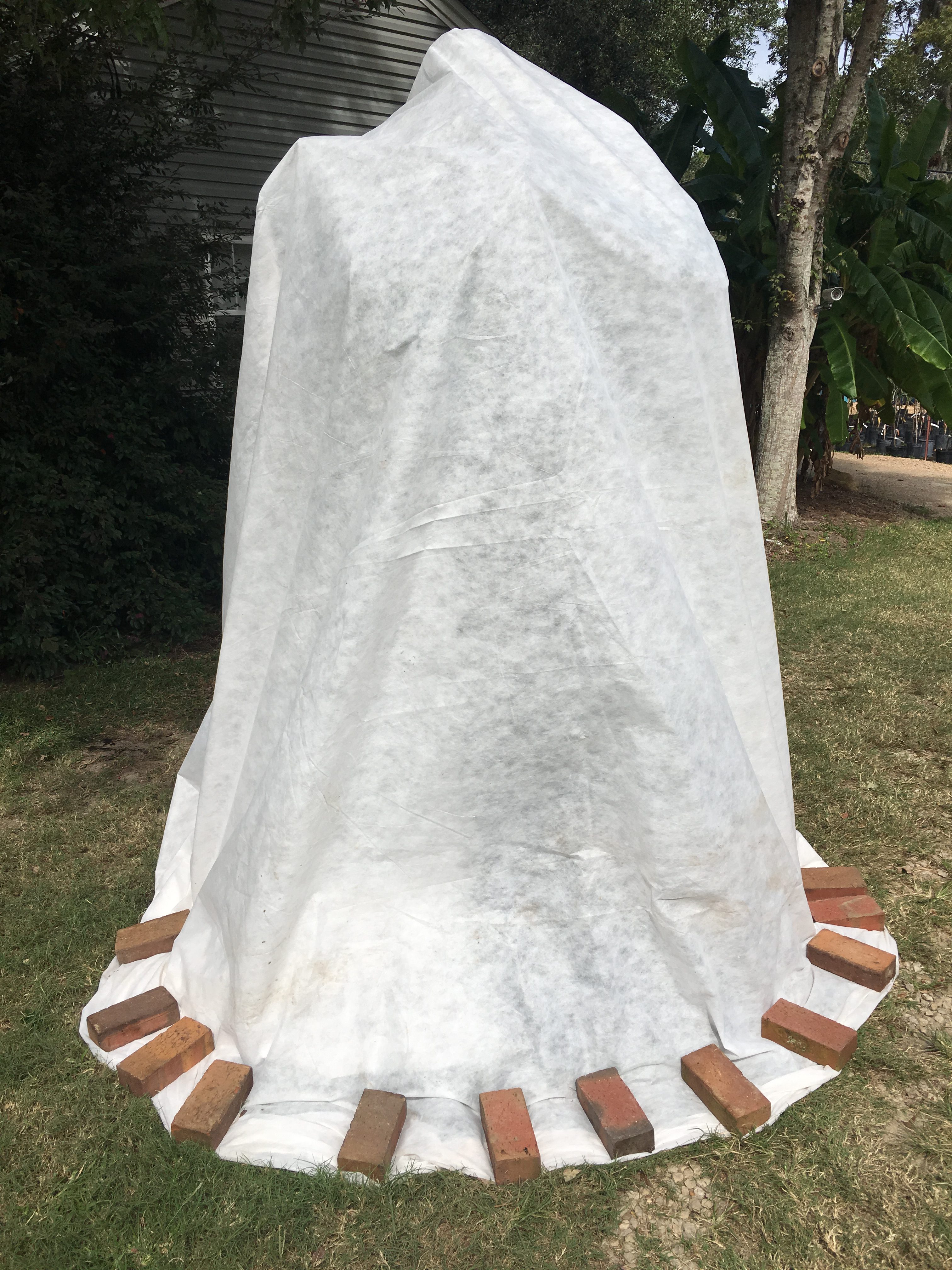
Use frost cloth to completely cover cold sensitive plants. Be sure to make complete contact with the ground and use heavy objects to keep the fabric secure. Photo by Jonathan Burns.
One major aspect that separates North Florida from South Florida is the discrepancies in air temperature. Although the differences are relatively small when comparing Florida with northern states, they can mean a world of difference in the plant world.
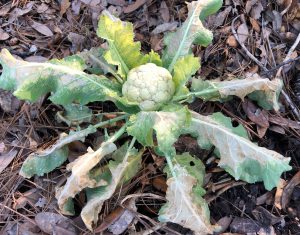
Even hardy cauliflower leaves can be damaged by cold winter nights in the Florida Panhandle. Photo by Molly Jameson.
In most of North Florida, our USDA plant hardiness zone is 8b, which means average minimum winter temperatures are between 15 and 20° Fahrenheit (F). We therefore can experience hard freezes, which happens when temperatures are below 28°F for over five hours. These types of conditions are capable of “burning” the leaves of even the toughest winter vegetables.
Fortunately for our winter gardens, average minimum winter temperatures are in the lower 40s, high enough not to damage winter garden crops. When we do have lows close to or below freezing (32°F), there is one very cost-effective method that can help keep crops and landscape plants protected. This is the use of a material called frost cloth.
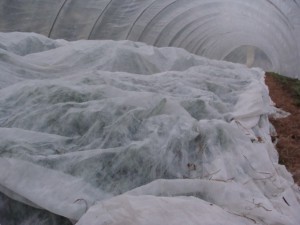
Frost cloth can moderate air temperatures six to eight degrees. Photo by Turkey Hill Farm.
Frost cloth, which can be purchased at most plant nurseries, is a breathable polyester fabric that is light weight and heat retentive. When used correctly, it can moderate air temperatures about six to eight degrees. This is typically all that is needed to get us through our mild North Florida winters. It is also relatively inexpensive, and if cared for, the same cloth can be used for many winter seasons.
Large blankets or bedsheets can be used as frost cloth substitutes, but whether you are using actual frost cloth, or something pulled from the linen closet, it is very important to use it correctly to be effective. The cloth must touch the ground at all points, as it works by trapping heat that radiates from the soil. It also increases the humidity around the plant, aiding in temperature moderation.
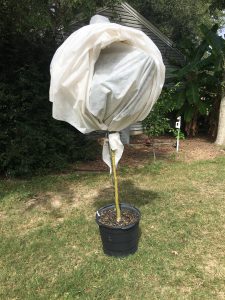
“Lollipop” trees will allow the heat from the ground to escape, giving the tree no cold protection. Photo by Jonathan Burns.
For sensitive landscape plants and fruit trees, it can be more difficult to fully cover the plant with the frost cloth to trap the heat, but it is just as important. When driving around town on a cold night, I inevitably encounter a few “lollipop” trees. This is when the foliage of the tree is wrapped in frost cloth, but the cloth does not reach the ground, and is typically tied off at the upper trunk of the tree. All heat moving upward from the soil will go right around the cloth, giving the tree essentially no protection.
Wire or PVC hoops can be used to help secure frost cloth and keep the cloth from damaging sensitive plant stems and leaves. Bricks, sticks, soil, or garden staples should be used along the perimeter of the frost cloth to prevent nighttime gusts from blowing the cloth off your garden beds or landscape plants. In the morning, remove the cloth once air temperatures reach about 50 to 60°F.
To learn more about cold protection, check out the UF/IFAS EDIS publication, Cold Protection of Landscape Plants (https://edis.ifas.ufl.edu/publication/MG025).
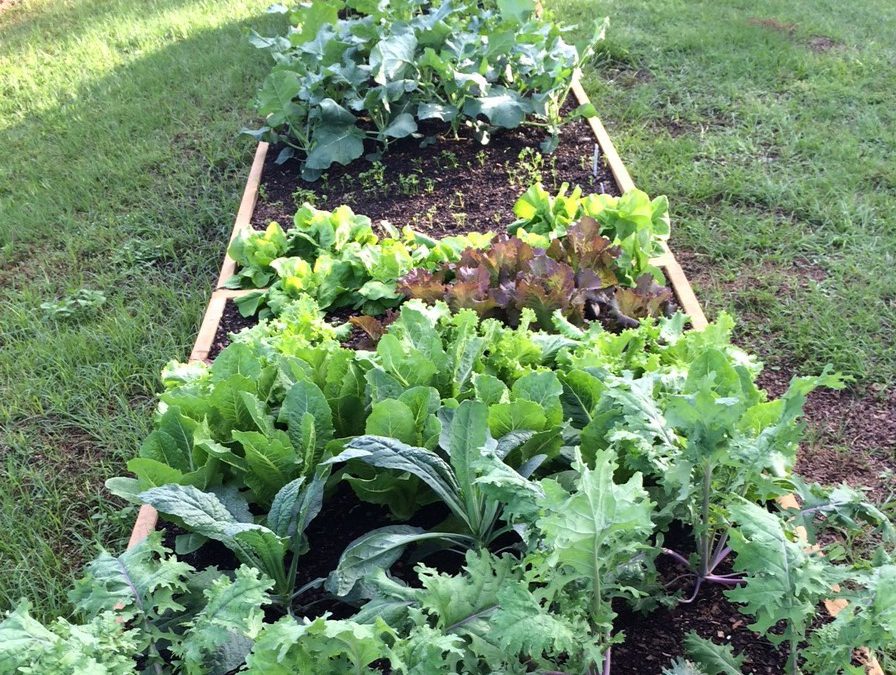
by Molly Jameson | Sep 16, 2016
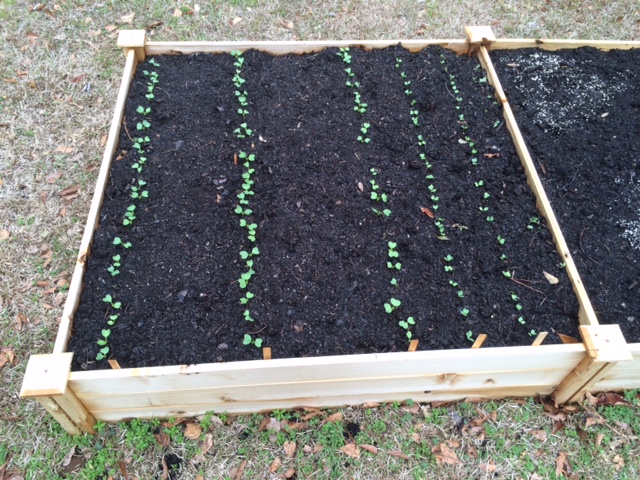
Direct seed root crops and many leafy greens, such as arugula and spinach. Photo by Molly Jameson.
Fall is fast approaching, and that means my favorite season for gardening has arrived! September is the month we get to start all of our fall favorites. For me, this means starting lettuce, kale, broccoli, and collards by seed in flats indoors. I use full-spectrum fluorescent bulbs, which mimics natural sunlight. In a couple of weeks, I will direct seed arugula, carrots, mustards, spinach, Swiss chard, and turnips into my raised beds.
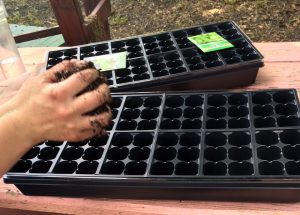
Seed brassicas and lettuce into flats. Photo by Molly Jameson.
But before I get started direct seeding, I will first need to do some garden cleanup. Sadly, this means I will need to say goodbye to my basil and okra, which are still hanging on despite the heat (and despite the hurricane!). Then it will be time to add a fresh layer of compost. Additionally, I will be adding worm castings, which I have been creating for my fall garden in my home worm bin all summer. There is no better feeling then growing brassicas and lettuce from seed, digging small holes, adding homemade fresh worm castings to each, and planting the eager seedlings.
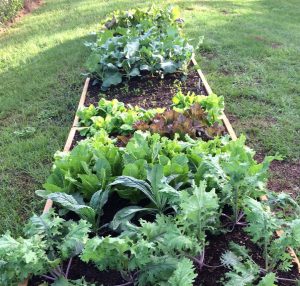
Grow a variety of greens for the fall season. Photo by Molly Jameson.
Fall is a wonderful time to garden in zone 8b – generally less pest pressure and a chance to plant hardy leafy greens that can be harvested all the way into spring. Of course, I always keep frost cloth around, in case temperatures dip below freezing for extended periods of time. In which case I will be sure to carefully cover my lettuce and Swiss chard, making sure the cloth is well secured.
I love my tomatoes, peppers, beans, and squash, but they usually involve staking and the ever imminent threat of caterpillars and intense heat. In the fall, most crops hold themselves off the ground, and I certainly cannot wait to pull on a jacket in the crisp early morning, come out to harvest kale and spinach leaves, and add them to my breakfast smoothie and veggie omelet.
For more information:
Florida Vegetable Gardening Guide
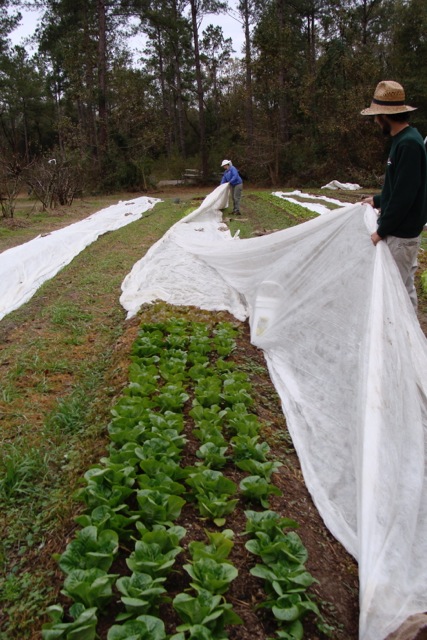
by Molly Jameson | Nov 4, 2015

Covering a row of lettuce with frost cloth at Turkey Hill Farm. Photo by Turkey Hill Farm.
While most of Florida does not have to worry about freezing winter weather, the Florida Panhandle is certainly an exception. North Florida experiences a few hard freezes – temperatures less than 28°F for over five hours – every year. Although most of our cold weather occurs in January and February, we can expect our first frost around the second week of November. Therefore, it is important for gardeners to be prepared.
Most of the Panhandle is in zone 8b, which means average minimum temperatures are between 15 and 20°F. Nights – especially consecutive nights – that get this cold can “burn” the tips of even the toughest vegetables, such as collards and kale. It is also important to remember that if you live in a more rural area, temperatures will be slightly cooler, relative to the city. Frost is also more likely to occur on clear nights, as heat that radiated down from the sun during the day will escape the atmosphere at night, if clouds are not present. Also, if you were late getting your fall garden started, it is even more important to protect your vegetable plants, as young plants are more susceptible to cold weather.
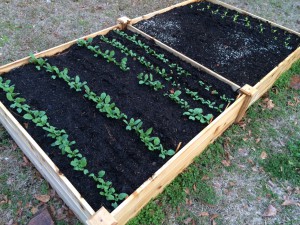
Young plants are more susceptible to cold weather, so be sure to use cold protection. Photo by Molly Jameson.
One strategy home gardeners can use to protect their plants during cold weather is to use frost cloth. Frost cloth is a breathable polyester fabric that is light weight and heat-retentive. It can moderate temperatures about six to eight degrees Fahrenheit. Use it on all of your garden plants if there is a hard freeze, but do not cover cold hardy vegetables in mild frosts, as their flavor can actually become sweeter in cool weather, and the plants will become more tolerant to the cold.
Frost cloth can be found at most plant nurseries, and it can last multiple years if you take care of it. Use wire hoops to keep the cloth off smaller crops, as ideally the cloth should not touch the plant. Most importantly, the cloth must touch the ground at all points to be effective, as it works by trapping heat that radiates from the soil and increases the humidity around the plant.
In the morning, do not remove frost cloth too early, as quick thawing can actually cause the most severe damage. Wait until the outside air temperature is about 50 to 60°F. Since frost cloth is breathable, if temperatures do not reach 50 to 60°F during the day, you can leave it on multiple days.

Frost cloth in high tunnel at Turkey Hill Farm. Photo by Turkey Hill Farm.
Sheets or blankets (not plastic) can be a frost cloth substitute, but there are disadvantages, such as not allowing proper air circulation or not being large enough to reach the ground.
Another strategy that can help keep your garden safe from cold weather is to keep your plants well watered, as frost damage is actually dehydration. When ice crystals form on the leaf surface, it draws moisture from the leaf tissue. Damage will therefore be less severe if the plant is not already drought-stressed. You can also mulch around the base of your plants with wood chips or straw to help moderate soil temperature and retain moisture.
Being prepared for cold weather will help keep your vegetable garden going strong all the way into the spring. Remember that healthy plants will be more resistant to cold weather than unhealthy plants, and investing in a few sheets of frost cloth can go a long way to ensure your veggies survive our chilly North Florida winters.











